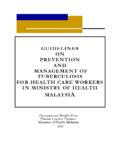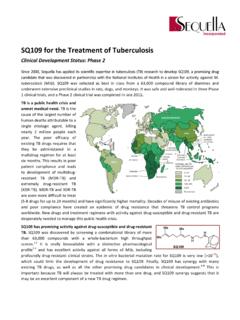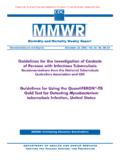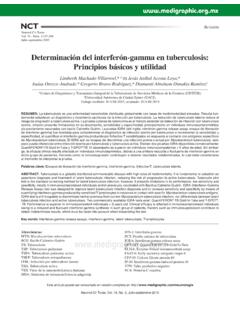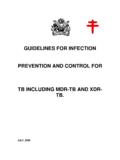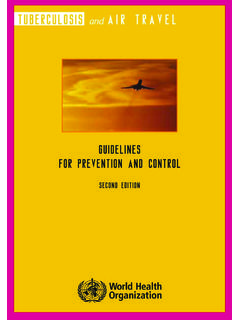Transcription of r
1 Morbidity and Mortality Weekly ReportRecommendations and Reports December 30, 2005 / Vol. 54 / No. RR-17 INSIDE: Continuing Education Examinationdepartment of health and human servicesCenters for Disease Control and PreventionGuidelines for Preventing the transmission of mycobacterium tuberculosis in Health-Care Settings, 2005 MMWR The MMWR series of publications is published by the Coordinating Center for Health Information and Service.
2 Centers for Disease Control and Prevention (CDC), Department of Health and Human Services, Atlanta, GA for Disease Control and PreventionJulie L. Gerberding, MD, MPHD irectorDixie E. Snider, MD, MPHC hief Science OfficerTanja Popovic, MD, PhDAssociate Director for ScienceCoordinating Center for Health Information and ServiceSteven L. Solomon, MDDirectorNational Center for Health MarketingJay M. Bernhardt, PhD, MPHD irectorDivision of Scientific CommunicationsMaria S. Parker(Acting) DirectorMary Lou Lindegren, MDEditor, MMWR SeriesSuzanne M.
3 Hewitt, MPAM anaging Editor, MMWR SeriesTeresa F. Rutledge(Acting) Lead Technical Writer-EditorPatricia McGeeProject EditorBeverly J. HollandLead Visual Information SpecialistLynda G. CupellMalbea A. LaPeteVisual Information SpecialistsQuang M. Doan, MBAE rica R. ShaverInformation Technology SpecialistsSUGGESTED CITATIONC enters for Disease Control and Prevention. Guidelines for Preventing the transmission of mycobacterium tuberculosis in Health-Care Settings, 2005. MMWR 2005;54(No. RR-17): [inclusive page numbers].
4 Disclosure of RelationshipCDC, our planners, and our content experts wish to disclose they have no financial interests or other relationships with the manufacturers of commercial products, suppliers of commercial services, or commercial supporters. Presentations will not include any discussion of the unlabeled use of a product or a product under investigational ..1 Overview ..1 HCWs Who Should Be Included in a TB Surveillance Program ..3 Risk for Health-Care Associated Transmission of M.
5 tuberculosis ..6 Fundamentals of TB Infection Control ..6 Relevance to Biologic Terrorism Preparedness ..8 Recommendations for Preventing Transmission of M. tuberculosis in Health-Care Settings ..8TB Infection-Control Program ..8TB Risk Assessment ..9 Risk Classification Examples ..11 Managing Patients Who Have Suspected or Confirmed TB Disease: General Recommendations ..16 Managing Patients Who Have Suspected or Confirmed TB Disease: Considerations for Special Circumstances and Settings ..19 Training and Educating HCWs.
6 27TB Infection-Control Surveillance ..28 Problem Evaluation ..32 Collaboration with the Local or State Health Department ..36 Environmental Controls ..36 Respiratory Protection ..38 Cough-Inducing and Aerosol-Generating Procedures ..40 Supplements ..42 Estimating the Infectiousness of a TB Patient ..42 Diagnostic Procedures for LTBI and TB Disease ..44 Treatment Procedures for LTBI and TB Disease ..53 Surveillance and Detection of M. tuberculosis Infections in Health-Care Settings ..56 Environmental Controls.
7 60 Respiratory Protection ..75 Cleaning, Disinfecting, and Sterilizing Patient-Care Equipment and Rooms ..79 Frequently Asked Questions (FAQs) ..80 References ..88 Terms and Abbreviations Used in this Report ..103 Glossary of Definitions ..107 Appendices ..121 Continuing Education Activity ..CE-1 Vol. 54 / RR-17 Recommendations and Reports 1 Guidelines for Preventing the transmission of mycobacterium tuberculosis in Health-Care Settings, 2005 Prepared byPaul A. Jensen, PhD, Lauren A. Lambert, MPH, Michael F. Iademarco, MD, Renee Ridzon, MDDivision of tuberculosis Elimination, National Center for HIV, STD, and TB PreventionSummaryIn 1994, CDC published the Guidelines for Preventing the transmission of mycobacterium tuberculosis in Health-Care Facilities, 1994.
8 The guidelines were issued in response to 1) a resurgence of tuberculosis (TB) disease that occurred in the United States in the mid-1980s and early 1990s, 2) the documentation of several high-profile health-care associated (previously termed nosocomial ) outbreaks related to an increase in the prevalence of TB disease and human immunodeficiency virus (HIV) coinfec-tion, 3) lapses in infection-control practices, 4) delays in the diagnosis and treatment of persons with infectious TB disease, and 5) the appearance and transmission of multidrug-resistant (MDR) TB strains.
9 The 1994 guidelines, which followed statements issued in 1982 and 1990, presented recommendations for TB-infection control based on a risk assessment process that classi-fied health-care facilities according to categories of TB risk, with a corresponding series of administrative, environmental, and respiratory-protection control TB infection-control measures recommended by CDC in 1994 were implemented widely in health-care facilities in the United States. The result has been a decrease in the number of TB outbreaks in health-care settings reported to CDC and a reduction in health-care associated transmission of mycobacterium tuberculosis to patients and health-care workers (HCWs).
10 Concurrent with this success, mobilization of the nation s TB-control programs succeeded in reversing the upsurge in reported cases of TB disease, and case rates have declined in the subsequent 10 years. Findings indicate that although the 2004 TB rate was the lowest recorded in the United States since national reporting began in 1953, the declines in rates for 2003 ( ) and 2004 ( ) were the smallest since 1993. In addition, TB infection rates greater than the average continue to be reported in certain racial/ethnic populations.











